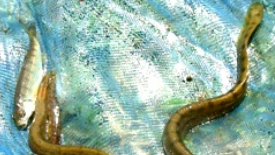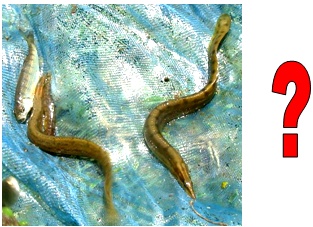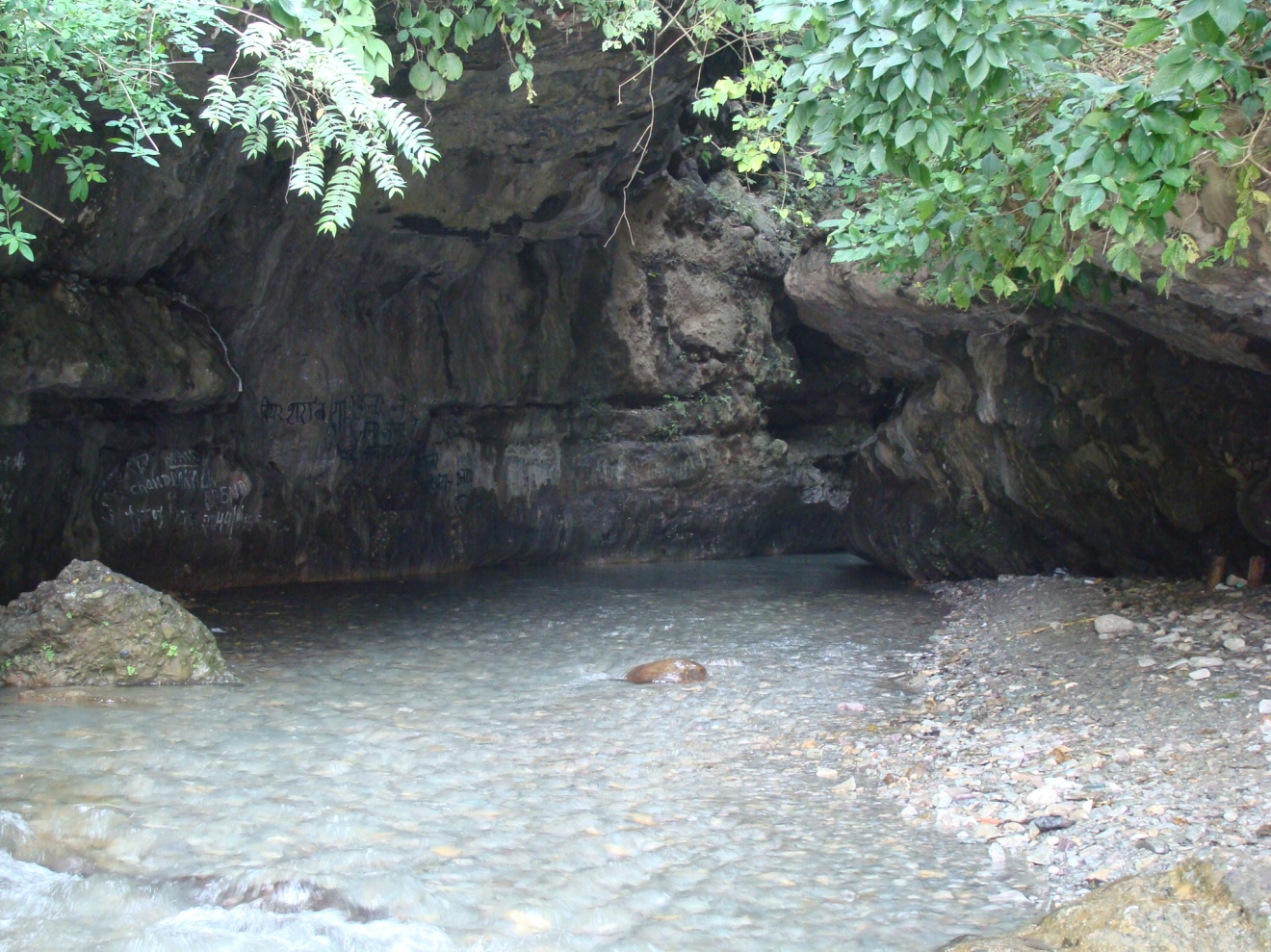The sorting of some fishes in the field / fresh market catches was made on the basis of SNAKE (= Eel) LIKE body and they were placed under ‘Lot 9’, tentatively labeled as Freshwater Spiny Eels or Mastacembelids.

Fresh, olive-brown specimens of Eel like fish, Mastacembelus armatus caught in the net, dragged through weedy thickets. A young Barilius bendelisis (Lot 3) specimen (with vertical bands descending from the back) is also lying beside it.
Habitat preferences
The fishes included in this ‘Lot’ were caught from rheophilic as well as marshy, muddy and pebbly stretches of Eastern (Song and Suswa) and Western Doon (Asan and Tons) rivers.
Though their body is best suited to live in holes, crevices and to wriggle under big boulders, they also prefer wriggling along the thickets of weedy substrata; the young ones dwelling comfortably in such weedy conditions.
Species segregation
While segregating this ‘Lot’, the samples were found belonging to two different Genera viz., Macrognathus and Mastacembelus [Order: Synbranchiformes, Family: Mastacembelidae]. They can be segregated into species on the basis of the following:
- Body elongated (max. 14.0 – 15.0 cm) and compressed. Dorsal and anal fins long but not confluent with rounded caudal fin. The soft Dorsal fin preceded by about 24 – 26 isolated spines (= Spiny Dorsal), increasing in size posteriorly. Pelvic Fins absent. Snout fleshy and trilobed with a concave non-striated lower surface. Olive green along the back, light yellow (pale) ventrally. Yellowish white spots present all over the flanks. It is commonly called as ‘Striped or Barred Spiny Eel’ owing to the presence of blackish bars along sides (continuing ventrally). Black, wavy spots continue up to head and on the soft dorsal, anal and caudal fins.
………………………. Macrognathus (=Mastacembelus) pancalus

- Body elongated and cylindrical (caudal region laterally compressed). Dorsal and anal fins long but confluent with the caudal fin (Young specimens show a shallow notch in between). The soft Dorsal fin preceded by about 32 – 39 isolated spines (= Spiny Dorsal), increasing in size posteriorly. Pelvic Fins absent. Snout fleshy and trilobed with a concave non-striated lower surface. Dark olive to olive-brown above, with zigzag bands/lines (hence commonly called Zigzag Eel or Tyre (Tire)-track spiny Eel) but paler ventrally. More pronounced in young ones, the undulating dark brown to black band traverses dorsolaterally from tip of snout to tail, the adult, large specimens (more than 30.0 cm) exhibiting dark bands across the back. Fins spotted or banded.
………………………. Mastacembelus armatus

Mastacembelus armatus: Fresh Specimen (Lateral view). Dorsal and anal fins long but confluent with the pointed caudal fin. Dark olive to olive-brown above, with zigzag bands/lines (yellow arrows) but paler ventrally (hence commonly called Zigzag Eel or Tyre (Tire) -track spiny Eel).
[This fresh specimen is from local Fish market at Banda (UP, India) [16.12.2019]. See the string (marked with blue arrows) which was used in a ‘throw a line and hook device’ to catch it from the rocky pools with crevices]

Mastacembelus armatus: Preserved Specimen (Lateral view). Dorsal and anal fins long but confluent with the caudal fin (blue arrow). Zigzag bands/lines on the flanks (yellow arrows). Prominent dark bands also lie across the back (becoming spots at the dorsal end of tail) (light blue arrows).

Mastacembelus armatus: Preserved Young Specimen (Lateral view). Zigzag bands/lines on the flanks (hence commonly called Zigzag Eel or Tyre (Tire) -track spiny Eel). More pronounced in young ones, the undulating dark brown to black band traverses dorsolaterally from tip of snout to tail.

Mastacembelus armatus: Dorsal part of the body magnified. Showing the isolated spines (32 – 39) preceding the rayed dorsal fin (yellow arrows).

[A string can be seen passing through the gill chamber; used in a ‘throw a line and hook device’ to catch it from the rocky pools with crevices]








